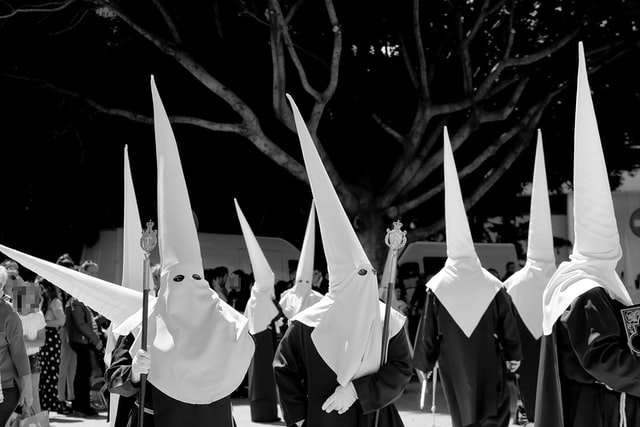A cathedral is a form of church where the seat of the Bishop is located. This is also a place where religious people go to meet, worship and pray God. But some cathedrals are among creepiest places in the world.
A church is a religious building. Its main role is to facilitate the gathering of a Christian community. Its construction must obey scheduling an architectural evolving over the centuries by its importance and function. It must be a place that reminds the members about God, not dead people or else. But these creepy places are all about human bones. These cathedrals are so creepy that they most resemble cemetery than church. They are among the creepiest places on earth.
There is no doubt the world contains amazing religious places, but these top seven would totally scary even bravest men… These catholic buildings are in several parties in the world: Rome, Peru … You are invited to discover 7 creepiest religious locations on earth that remind us a horror movie instead God.
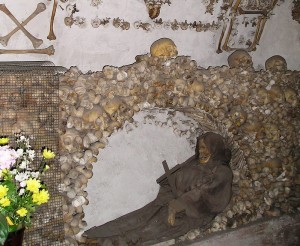
Our Lady of the Conception of the Capuchins, also called Santa Maria Della Concezione dei Cappuccini, is a Roman Catholic Church located in Rome, Italy…. It was commissioned by Pope Urban VIII for his younger brother, Cardinal Antonio Barberini, who was a member of the Capuchin order.
The Cardinal Barberini decided to transfer in the crypt (an underground room or vault beneath a church) of the Capuchin the remains exhumed of the old cemetery of the Santa Croce e San Bonaventura dei Lucchesi. Thereafter, the Capuchin friars continued to deposit their dead.
By the mid 18th century and until 1870, the mortal remains will be placed into “works of art” made of macabre ornaments in baroque style. At the entrance, an inscription in 3 languages welcomes you with these words: “What you are now, we once were; what we are now, you shall be.”
The crypt contains the remains of about 4000 Capuchin Friars collected between 1528 and 1870… The walls are decorated with ornaments made from human bones and form a macabre decoration. Some skeletons dressed in monk’s frock are arranged in monastic postures.
6. The Skull Chapel, Czermna
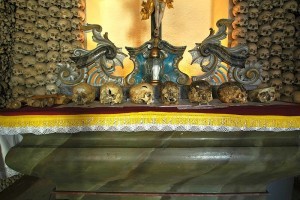
But as the name suggests, Skull Chapel is not an ordinary church. It is the mass grave of people who died during the Thirty Years’ War (1618–1648), three Silesian Wars (1740–1763), as well as of people who were killed by cholera epidemics, plague, syphilis and hunger.
Together with J. Schmidt and grave digger J. Langer, father Tomaszek spent 18 years (from 1776 to 1794) collecting and cleaning human bones, and put them in the chapel. In addition to 21,000 people interred in the basement, The Walls of Skull Chapel are filled with 3000 skulls.
The skulls of people who built the chapel, including father Tomaszek, were placed in the center of the building and on the altar in 1804. Inside are a crucifix and two carvings of angels, one with a Latin inscription that reads “Arise from the Dead.”
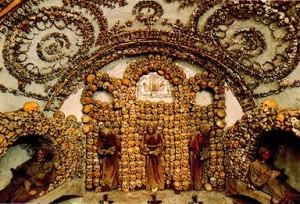
The Capuchin Crypt is a set of several small chapels located beneath the church of Santa Maria della Concezione dei Cappuccini in Rome, Italy. This is a creepy location containing 1000s of human remains.
Capuchin Crypt has skeletal remains of 3,700 bodies of Capuchin friars. It is believed those believers, before their death, asked to be buried in the chapels to assure their eternal life in heaven. The bodies also meant to remind us, the living, our own mortality.
This is one of the most macabre religious locations on earth. In fact, Frommer’s, a travel guidebook series, describes the location as “one of the most horrifying images in all of Christendom.”
There are five rooms in the crypt that feature a unique display of human bones:
1. Crypt of the Resurrection, featuring a picture of Jesus raising Lazarus from the dead, framed by various parts of human skeletons.
2. Crypt of the Skulls, featuring human skulls
3. Crypt of the Pelvises, attributing to human Pelvic bones
4. Crypt of the Leg Bones and Thigh Bones, containing legs and thighs
5. Crypt of the Three Skeletons: the center skeleton is enclosed in an oval, the symbol of life coming to birth. In its right hand it holds a scythe, symbol of death which cuts down everyone, like grass in a field, while its left hand holds the scales, symbolizing the good and evil deeds weighed by God when he judges the human soul. A placard in five languages declares: “What you are now we used to be; what we are now you will be…”
4. The Capela dos Ossos (Chapel of Bones)
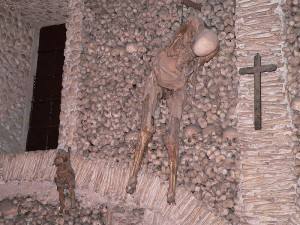
The objective behind the construction of the chapel is to oppose the reform movement of the Protestants. The monk wanted to lead the protestants to contemplate the ephemeral and transitory nature of life… This is clearly expressed through the inscription at the entrance: aqui estamos Nós ossos that pelos Vossos esperamos (“We bones that here are, for yours wait”).
The chapel measures 18.7 × 11 meters. Light enters only via three small openings on the left. Its walls and eight columns are “decorated” with carefully arranged long bones and skulls held by cement. The ceiling is made of bricks painted white and decorated with morbid patterns.
It took 5000 skeletons to achieve the work. Some skulls are decorated with graffiti. Two desiccated corpses, including a child, are hung by chains. On the ceiling is written a text from Ecclesiastes 7:1, “Melior dies mortis nativitatis die” (“The day of death is better than that of birth”).
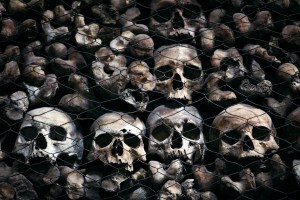
San Bernardino alle Ossa is a church in Milan (Italy), which was built in 1145, then restored en1679. It is mainly known for hosting a side chapel decorated by an ossuary with human skulls and bones.
The walls are niches decorated with human bones in a rococo style, an 18th-century artistic style. The bones come from the adjoining cemetery, closed in conjunction with the adjoining hospital in 1652. The doors and cornices of the ossuary are also decorated with human bones.
San Bernardino alle Ossa contains thousands of human bones. The entire bones form decorations of the cross and mortuary symbols, while giving an impression of Baroque delicacy.
Although most people find the church too creepy, In 1738 King John V of Portugal was so impressed with the chapel that he built a similar one in Evora, near Lisbon. Until now, thousands of tourists visit San Bernardino alle Ossa every year.
2. Saint Francis Monastery located in Lima, Peru
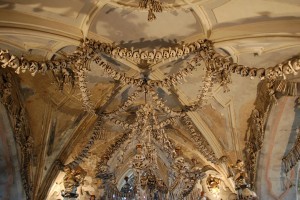
In addition to the church and monastery, there are a library and catacombs. The sanctuary (a holy or sacred place) is dedicated to the apostle Jude. During the feast of the Saint (Saint Jude Tadeus), one ton and half silver is transported from the basilica in a procession by 40 people.
The catacombs contain 1000s of human skulls and bones. The catholic historians claim the location was served as a burial-place until 1808, when the city cemetery was opened outside Lima. But some historians believe some of those people were killed by the Church.
It is estimated that there are 25,000 human skeletons in the monastery. The crypts, built of bricks and mortar, are very solid and have stood up well to earthquakes. It is also believed there existed secret passageways that connect to the Cathedral and the Tribunal of the Holy Inquisition.
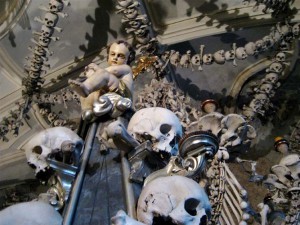
The Sedlec Ossuary is a Catholic chapel located in the Cemetery Church of All Saints in Sedlec, Czech Republic. It is a small church but also 1 of 12 World Heritage Sites in the Czech Republic.
The first mentions of a decoration with human bones in the chapel back to the 17th century. Between 1700 and 1709 a Baroque reconstruction of the Chapel of All Saints was planned and ordained by the architect Jan Santini Aichel.
The Sedlec Ossuary contains the skeletons of up to 70,000 people, whose bones have in many cases been artistically arranged to form decorations and furnishings for the chapel. The place is very creepy but also touristic, receiving over 200,000 visitors each year.
The church has a distinctive design. 4 enormous bell-shaped mounds occupy the corners. An enormous chandelier made of at least one of every bone in the human body hangs from the center of the nave with garlands of skulls draping the vault…

